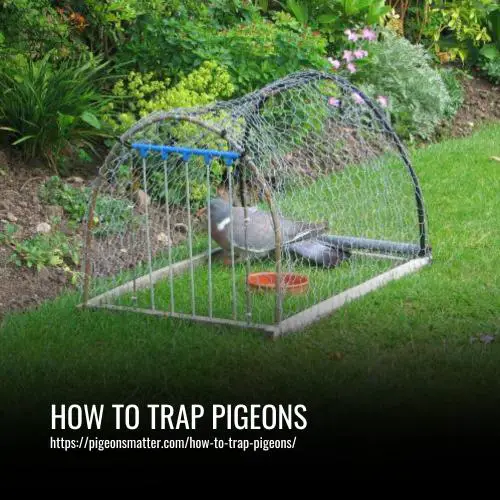To trap pigeons, it’s important to understand that the birds originally came to North America as domesticated birds and have since become a pest in many cities. Trapping pigeons is a different challenge than trapping animals that cannot fly, so it requires a different approach. To trap a large number of pigeons that have taken over a specific area, a focused strategy is necessary.
One effective method is to use a multi-catch trap, which can capture multiple pigeons at once. This type of trap is designed to attract pigeons with bait and then close behind them, preventing their escape. It’s important to place the trap in the birds’ feeding or roosting areas and use bait that will specifically attract pigeons.
Another approach is to use a live pigeon trap, which involves using a cage or net to capture individual birds. This method requires patience and precise placement of the trap to ensure success.

Choosing The Right Trap To Catch The Pigeon
When choosing a trap to catch pigeons, it’s important to consider the size of the area and the number of birds you need to trap. For smaller-scale bird control, commercially available traps can be effective for catching one or two birds. However, for larger colonies of pigeons, a custom-built cage trap may be necessary.
The most common type of trap is a live trap, which is a large cage with a one-way entrance that allows pigeons to access the bait but prevents them from escaping. This method is preferred for those who do not want to handle carcasses, as the birds can be safely removed and released.
For those who do not mind dealing with carcasses, using a live trap with poison bait is an option. However, it is best to avoid using poison outside of a trap, as it can lead to carcasses being left in hard-to-reach areas.
Locating And Baiting Your Trap
When preparing to trap pigeons, it’s important to lay out bait without the trap for about a week to condition the pigeons to the area. Once they are accustomed to finding food there, set the trap.
Choose a location where pigeons are the only likely animals to get caught, and check the trap regularly to avoid catching other birds or pests. If using poison bait, the trap must be supervised at all times to prevent other animals from being harmed.
Most people use live traps to avoid this risk. By following these steps, you can effectively locate and bait your trap for pigeon trapping.
Different Types Of Pigeon Traps
Pigeon infestations can be a common problem, especially in urban areas. To effectively control their population, various types of pigeon traps can be used. Whether you’re dealing with a few pesky pigeons or a larger-scale infestation, it’s important to understand the different types of pigeon traps available to effectively and humanely capture these birds.
1. Cage Traps:
- Larsen cage traps and larger crow or ladder traps are commonly used to catch birds.
- Larsen traps usually have multiple compartments and are mobile, while ladder traps are left in one position.
- Both types use bait to lure birds into the trap.
2. Net Traps:
- Net traps are designed to catch birds alive, entangling them in the net.
- Cannon nets can catch multiple birds at once, covering a specific area when triggered.
- Mist nets are stretched between trees or poles and trap birds that fly into them.
3. Clap Traps:
- These traps can be designed to catch or kill birds and use a spring-loaded frame with a net to quickly close around the bird when triggered.
- Best for birds that land in easily accessible spots and require regular monitoring.
4. Lethal Traps:
- The use of lethal traps should be checked with local wildlife departments to ensure legality.
- Deadfall traps involve a heavy stone falling on the bird when triggered.
- Other methods include using poison bait in cage traps or disposing of trapped birds humanely.
Handling And Removing Pigeons
When handling pigeons, it is important to minimize contact and wear thick gloves and clothing to prevent contamination from diseases found in the droppings. It is best to adhere to state laws and regulations regarding the removal and release of pigeons, as some states may require humane euthanization or have specific contacts for taking the birds.
If releasing pigeons, it is important to take measures to exclude them from returning by modifying the property where trapping takes place to prevent their homing instinct from bringing them back.
How Do You Bait A Pigeon Trap?
When baiting a pigeon trap, it is best to use food that pigeons are familiar with and will be attracted to. Common bait includes corn, wheat, bread, and birdseed. For cage traps, use small amounts of bait placed near the entrance of the trap. If using a net or claptrap, spread larger amounts of bait around the area where you plan on trapping.
- Choose a trap: Research and select a pigeon trap that suits your needs.
- Bait the trap: Use birdseed, corn, or wheat to attract pigeons into the trap.
- Set the trap: Place the baited trap in an area where pigeons gather and ensure it is stable.
- Check the trap: Periodically inspect the trap to see if any pigeons have been caught. Release any trapped pigeons far away from your home.
- Repeat as necessary: Be patient and set the trap multiple times if needed to effectively get rid of the pigeons around your home.
What Kind Of Food Do Pigeons Like?
Pigeons mostly like grain and seeds. In the wild, they forage for a variety of seeds from grasses, shrubs, and trees, as well as other plant material like buds, leaves, and fruits. In captivity, they are usually fed a diet of commercial pigeon feed, which is a mix of different seeds. Pigeons also enjoy eating grit, which helps them grind up food in their gizzard. Grit can be provided by offering a dish of sand or small rocks.
Additionally, pigeons need a source of water to stay hydrated. In the wild, they drink from puddles, ponds, and streams, while in captivity, clean water should be provided in a dish for them to drink from.
Alternative Ways Of Dealing With A Bird Problem
- Install bird spikes on roof ridges and window sills where birds are landing and causing a nuisance.
- Bird spikes are an easy way to drive birds away.
- Try anti-bird netting to cover larger areas and prevent birds from landing on rooftops.
- Mount anti-bird netting several inches above the surface of the roof to effectively deter birds.
- Pigeons can create messes and health hazards with their droppings.
- These alternative measures can help homeowners and business owners deal with bird problems more effectively than trapping.
FAQs
To set a pigeon trap, a trap specifically designed for pigeons needs to be purchased. Once acquired, it should be baited with food that will attract pigeons, such as birdseed, berries, or dried corn. The trap should then be placed in an area where pigeons are known to congregate, such as near a birdfeeder or on a windowsill. It’s important to check the trap regularly, as pigeons can die of dehydration or stress if left in the trap for too long.
There are a few ways to catch a pigeon. One way is to use a net to capture the bird. Another way is to use a trap specifically designed for pigeons. Both methods may require patience and caution to successfully catch a pigeon without causing harm to the bird.
The ideal spots for pigeon traps are areas frequented by pigeons, such as rooftops, ledges, or near food sources. Choose places where pigeons roost or feed regularly for optimal trapping.
Pigeons are attracted to grains and seeds like cracked corn, millet, or wheat. These can be used effectively as bait. Additionally, breadcrumbs and birdseed mixes are also enticing to pigeons.
Placing the bait inside the trap and around its entrance will entice pigeons to enter. Ensure the trap door is set up in a way that allows easy access for the pigeons but prevents them from leaving once inside.
Laws regarding trapping pigeons may vary by location. In some areas, trapping pigeons may require a permit or may be regulated by local wildlife authorities. It’s advisable to check with local authorities to ensure compliance with legal regulations.
It’s recommended to check the trap regularly, ideally every few hours, to prevent captured pigeons from experiencing undue stress or harm. This also allows for the timely release of non-target animals and prevents overcrowding in the trap.
Once trapped, pigeons can be safely and humanely relocated to a suitable area away from the trapping site. Ensure the release area is appropriate for pigeons and complies with local regulations regarding wildlife relocation.
Conclusion:
Trapping pigeons can be a useful and effective way to manage their population and protect your property. Remember to always follow local laws and regulations when trapping pigeons, and consider humane methods to ensure the well-being of these birds.
With the right knowledge and approach, you can successfully trap pigeons and create a safer environment for yourself and your community. Happy trapping!



